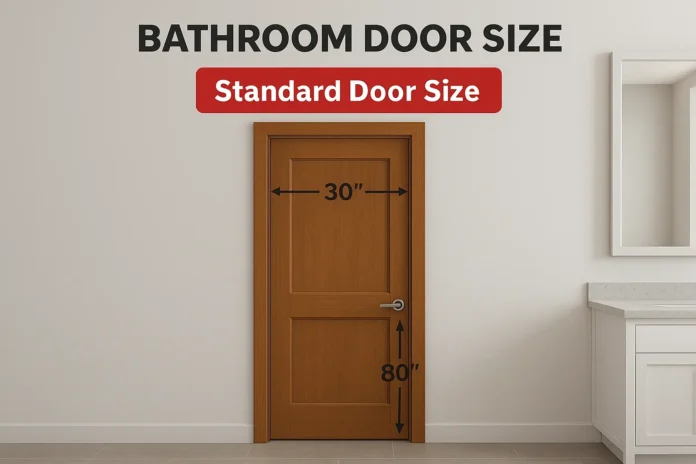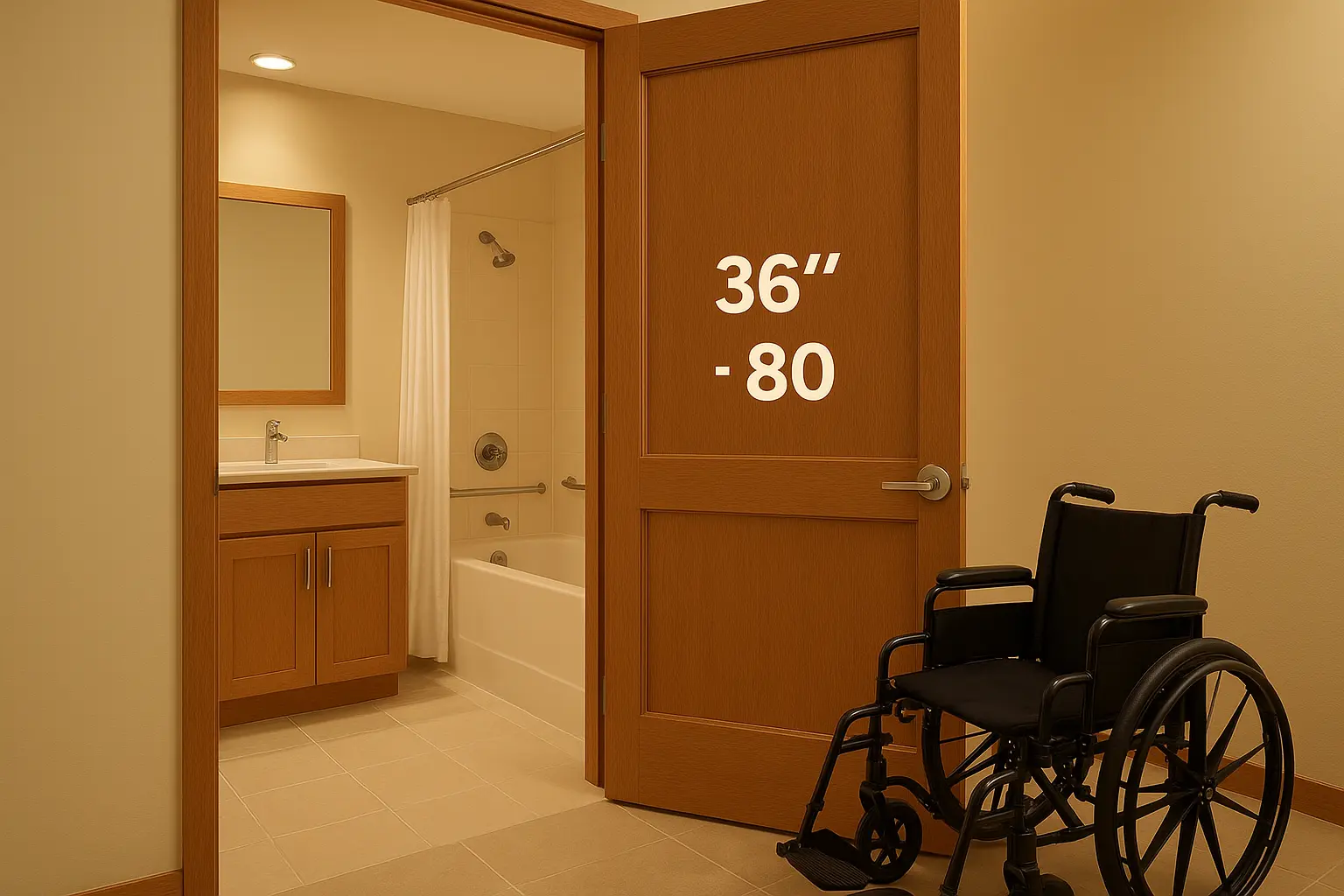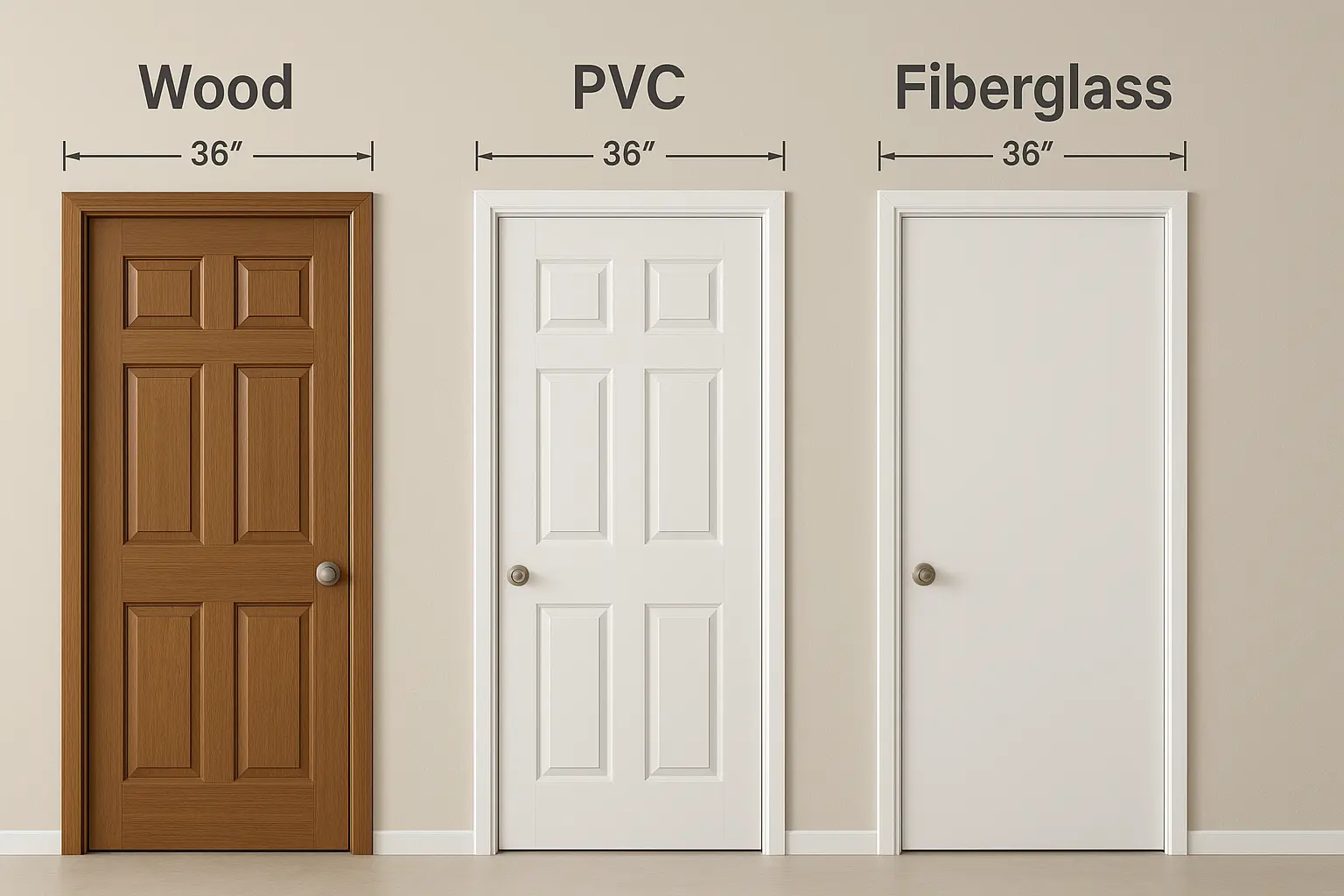
Choosing the right bathroom door size standard makes sure comfort, accessibility and safety for every household. A properly sized door allows easy movement, gives privacy and keeps the bathroom looking balanced and functional.
If you’re updating a small bathroom or making a new one, once you know the common door sizes, choosing becomes simple.
Here’s what you need to know about the most common bathroom door sizes in inches, feet and millimeters. It also shows frame measurements, material options and accessibility standards.
If you pick the right door width and height, homeowners can create bathrooms that are stylish, practical and that meet U.S. building rules” / “that follow U.S. code.
Why Bathroom Door Size Matters
The bathroom door size standard matters a lot in how comfortable and accessible a home feels. A door that’s too narrow can limit movement, especially for children, seniors, or anyone using mobility aids.
Wider doors improve accessibility and safety while keeping layouts efficient. Beyond space and movement, door size also affects privacy, airflow, and lighting.
The correct bathroom door width requirements help reduce humidity buildup and keep the room fresh.
So it stays comfortable and meets the rules, the right door size supports both design and daily use.
What Is the Standard Bathroom Door Size?
The standard bathroom door size in the U.S. is usually 32 inches wide and 80 inches tall. This size fits most homes and provides easy movement for daily use.
Smaller bathrooms might use 24- to 28-inch-wide doors to save space, while accessible or family bathrooms often choose 36 inches for better comfort.
Here’s a quick look at common standard bathroom door dimensions in different units:
- Inches: 24, 28, 30, 32, 36
- Feet: 2 – 3 ft width, 6.67 ft height
- Millimeters: 610 – 914 mm width, 2032 mm height
These measurements help homeowners choose the right fit for their layout and style.
Following the bathroom door width requirements also make sure compliance with ADA compliant bathroom door standards, giving everyone easier and safer access.
Bathroom Door Dimensions in Different Units

Understanding bathroom door dimensions in various units helps when buying or measuring doors from different suppliers. Most manufacturers use inches, millimeters, or feet to describe door size.
Knowing how they compare saves time and avoids costly mistakes during installation.
Here’s a quick conversion chart for standard bathroom door size:
| Measurement Unit | Common Widths | Common Height |
| Inches | 24, 28, 30, 32, 36 | 80 |
| Feet | 2, 2.5, 2.67, 3 | 6.67 |
| Millimeters (mm) | 610, 711, 762, 813, 914 | 2032 |
Smaller doors (24–28 inches) fit compact bathrooms, while 32- to 36-inch doors are better for standard or wheelchair accessible bathroom doors.
When converting, remember that 1 inch equals 25.4 mm. Accurate bathroom door frame measurements ensure the door fits properly within its frame, improving both design and function.
Bathroom Door Size by Material Type
Bathroom doors come in several materials, and each type slightly affects the standard dimensions and durability.
The material you choose determines the door thickness, moisture resistance, and long-term maintenance needs.
1. Wooden Doors
Wooden doors offer a warm natural appeal and are typically 1.5 inches thick with widths ranging from 24 to 36 inches.
Since wood absorbs moisture, applying a waterproof sealant helps prevent swelling and warping in humid bathrooms.
2. PVC Bathroom Doors
PVC doors are lightweight and cost-effective, ideal for moisture-prone environments. The average PVC door measures 24 to 32 inches wide and 80 inches tall.
They resist water damage and are easy to maintain, making them a smart choice for busy households.
3. Fiberglass and Composite Doors
Fiberglass and composite materials provide excellent moisture resistance and insulation. The standard thickness ranges from 1.375 to 1.75 inches, fitting smoothly within a 4.5 to 5.5 inch door frame.
These doors are durable, low maintenance, and suitable for both modern and traditional bathroom designs.
When selecting materials, think about durability, cost, and the bathroom’s humidity level. The right choice keeps your space functional and reduces long-term maintenance.
Door Width and Height Standards Explained
Standard interior door measurements, including bathroom doors, typically range from 28 to 32 inches in width and 80 inches in height.
These sizes keep things comfortable and easy to move around in most U.S. homes.
For accessible or larger bathrooms, a 36-inch width is ideal to meet ADA-compliant door requirements, so people using wheelchairs or walkers can move easily.
The door frame typically measures 4.5 to 5.5 inches thick, allowing the slab to fit and swing smoothly.
Door thickness itself ranges from 1.375 to 1.75 inches, depending on material and design.
Standard bathroom door size equivalents include 2.5 × 6.67 feet or 813 × 2032 mm, helping homeowners compare options across measurements.
Getting these dimensions right before you buy or install, to avoid poor fitting or extra costs.
Accessibility and ADA Compliance

ADA rules cover more than just width. The idea is simple — it should be safe and easy for anyone to use.
So it’s easy for everyone to use, there should be at least 32 inches of clear opening space when the door is open at 90 degrees.
The swing direction should not block access to sinks, toilets, or grab bars. Pocket doors or sliding doors can also be practical in tight spaces.
Door handles must be mounted between 34 and 48 inches from the floor and designed for easy grip—lever handles are preferred over knobs for better accessibility.
The area around the door should have enough clear floor space (typically 60 inches in diameter) to allow wheelchair turning.
If you’re planning or remodeling, check ADA design guides or local building codes to ensure compliance.
These small details improve everyday usability and create a bathroom that’s safe and comfortable for everyone.
Compact Bathrooms: Space-Saving Door Options
Small bathrooms need doors that save space without sacrificing style or comfort.
The best bathroom door size for compact spaces is usually between 24 and 28 inches wide, helping maximize floor area while keeping the room easy to use.
Sliding and pocket doors are popular choices for tight areas. A sliding bathroom door moves along the wall, so there’s no swing space needed.
A pocket door slides into the wall itself, giving a clean, open look when not in use.
For even smaller layouts, a bi-fold door can work well since it folds inward and takes up minimal space.
When picking a design that saves space, it’s important to check door frame thickness, which is often around 4.5 inches in modern homes.
A properly sized frame keeps the door secure and make sure smooth opening and closing.
Compact doors save space and still look clean and simple.
Bathroom Door Frame Measurements
The frame really affects how the door fits and works. The standard door frame size depends on the door width and wall thickness.
In most U.S. homes, a standard interior door frame size measures between 4.5 and 5.5 inches thick, which matches typical wall construction.
Standard bathroom door dimensions are 32 × 80 inches or roughly 813 × 2032 mm when converted to metric.
For compact bathrooms, the frame might fit a 24-inch or 28-inch door.
Larger bathrooms or accessible spaces often use a 36-inch-wide door frame to meet ADA-compliant bathroom door standards.
Builders and homeowners should always check door frame measurements before installation.
A door frame that’s too narrow can cause the door to stick, while one that’s too wide may leave gaps.
Good measurements help line up the hinges and latch right for smooth operation.
If the wall is thicker or has extra layers like tile or wainscoting, a custom door frame thickness may be required.
Getting the size right saves you time during installation and improves both the look and durability of your bathroom door.
Design and Aesthetic Considerations
A bathroom door isn’t just a barrier. It’s part of the room’s personality. The right design pulls the look together and keeps it comfortable.
Color and Finish
Light tones help small bathrooms appear larger while dark finishes add contrast and a modern touch.
Matching the door color with trims or tiles creates a seamless and polished look.
Ventilation and Details
Small air gaps or louvered panels improve airflow and protect the door from moisture buildup. These details help maintain both door quality and indoor freshness.
Style and Hardware
Decorative trims, frosted glass inserts, and sleek handles enhance both the appearance and ease of use.
A well-chosen design balances privacy with style and turns a simple bathroom door into a visual highlight of the space.
Bathroom Door Safety and Building Standards
Safety is just as important as style when choosing a bathroom door size. Every door should follow basic safety codes so it lasts and works well.
In the U.S., most local codes recommend that interior bathroom doors open outward or slide to prevent blocking the path in an emergency.
The standard bathroom door dimensions—about 32 inches wide and 80 inches tall—allow easy exit if help is ever needed.
Moisture resistance is another key safety factor. Fire-rated and water-resistant doors help prevent damage from humidity and reduce the risk of mold.
Materials like fiberglass, PVC, or laminated wood are preferred because they resist swelling and warping.
Proper hardware also matters. Non-slip handles, smooth locks, and sturdy hinges keep doors functional and safe for daily use.
Installing the correct door swing direction and ensuring proper clearance help maintain both safety and comfort in compact bathrooms.
These safety rules protect your home and keep it up to code with U.S. construction regulations.
Customization and Renovation Tips

Every home is unique, and so are bathroom doors. You can update your door to fit your space and budget.
The right bathroom door size can be adjusted during renovations to improve comfort and function.
When planning a remodel, refer to a trusted bathroom renovation guide and measure the door frame thickness carefully before ordering.
A small mistake in door width or height can lead to fitting problems and extra costs.
For older homes, resizing the frame might be necessary to meet modern bathroom door dimensions or ADA-compliant standards.
Customization options include:
- Handles and Locks: Choose smooth, rust-resistant hardware that fits your home’s design.
- Finishes and Colors: Paint or laminate for moisture protection and style.
- Door Swing or Sliding Options: Sliding and pocket doors save space in smaller bathrooms.
- Materials: Replace old wood doors with PVC or fiberglass for better durability and lower maintenance.
Even simple updates like adding a new handle or refinishing the surface can make a noticeable difference.
When renovating, try to mix looks and safety so it’s both nice and sturdy.
Common Bathroom Door Sizes by Region
Bathroom door sizes vary slightly by region, but most U.S. homes use a standard 32-inch width and 80-inch height.
This size provides a good balance of comfort, accessibility, and design consistency.
In smaller homes or apartments, 24-inch or 28-inch widths are popular space-saving options.
Larger or ADA-compliant bathrooms often feature 36-inch wide doors for smoother wheelchair or stroller access. These dimensions align with most standard U.S. door frames.
Outside the U.S., measurements are usually listed in centimeters or millimeters, such as:
- 610 × 2032 mm (24 × 80 in.) – small bathrooms
- 813 × 2032 mm (32 × 80 in.) – standard bathrooms
- 914 × 2032 mm (36 × 80 in.) – accessible bathrooms
In regions using the metric system, widths typically range from 70 to 91 cm and heights near 200 cm.
No matter the measurements, the goal is comfort and easy access for every type of bathroom layout.
Choosing the Right Bathroom Door for Your Home

Picking a bathroom door is about more than just size. The ideal bathroom door size should balance comfort, safety and style while fitting your home’s layout.
When planning, start with accurate measurements of your doorway. The standard interior door width for most U.S. homes is 28 to 32 inches while accessible bathrooms may need 36 inches.
Always measure both the door frame size and wall thickness before installation to avoid gaps or fitting issues.
Material choice also matters. PVC doors are lightweight and moisture resistant, perfect for humid areas. Wooden doors add warmth but may need more maintenance.
Fiberglass or composite designs are strong, long lasting and resist warping.
If your space is small, consider sliding or pocket doors. They save space without sacrificing privacy or appearance.
For homes with kids or seniors, wider doors improve accessibility and safety.
When budgeting, remember that standard bathroom door sizes in the U.S. are easier to find and install.
Custom sizes may cost more but can perfectly match unique layouts or design goals.
Before you finish up, double-check local codes and follow some pro tips to get a lasting fit.
The right door doesn’t just fit — it enhances how your bathroom feels and functions every day.
If you want a full bathroom renovation guide covering door styles, measurements and smart remodeling ideas, visit Redfinz.com for expert insights and inspiration.
Frequently Asked Questions
Q 1. What is the ideal bathroom door size for most homes?
A: In most U.S. homes, a bathroom door size between 30 and 32 inches wide and 80 inches tall works best. It fits standard frames while allowing smooth movement and privacy.
Q 2. Are 24-inch bathroom doors still practical?
A: A 24-inch bathroom door suits compact layouts or powder rooms where space is limited. It’s a good option if a larger size won’t fit, but not ideal for everyday or shared bathrooms.
Q 3. Why is ADA-compliant door width important?
A: Following ADA-compliant bathroom door standards helps make your space easy for everyone to use, especially for people using wheelchairs or walkers. It also meets U.S. building codes.
Q 4. Which material lasts longest in bathroom humidity?
A: Fiberglass and PVC bathroom doors resist moisture and warping better than solid wood. They’re great for high-humidity areas while still looking stylish.
Q 5. How should homeowners measure a bathroom door?
A: Measure from frame to frame for width, top to bottom for height, and check the frame thickness. These three numbers help you choose the right size for smooth fitting and lasting performance.
Conclusion
Picking the right bathroom door size improves comfort, safety, and everyday use. Measure carefully, choose the right materials, and follow ADA standards for accessibility.
For more practical guides, you can check Redfinz.com.





